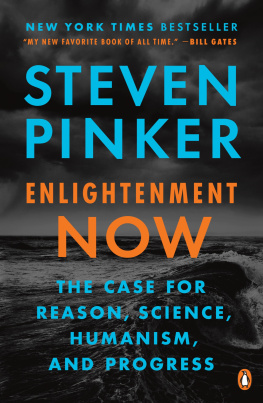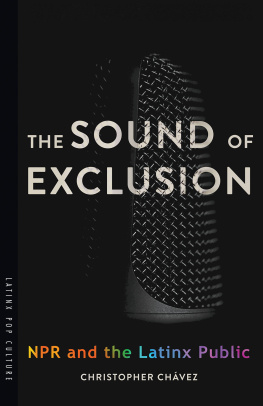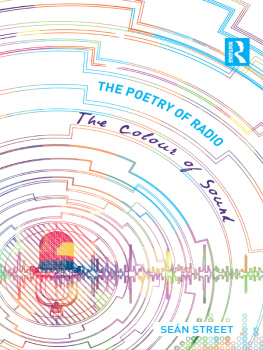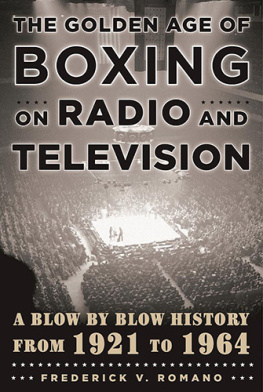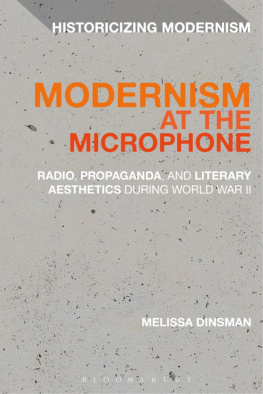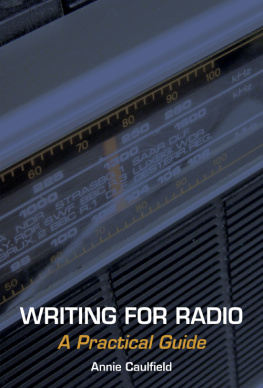Lost Sound

Lost Sound
The Forgotten Art of Radio Storytelling
Jeff Porter
The University of North Carolina Press
Chapel Hill
2016 The University of North Carolina Press
All rights reserved
Manufactured in the United States of America
Designed by Alyssa DAvanzo
Set in Calluna by codeMantra, Inc.
The University of North Carolina Press has been a member of the Green Press Initiative since 2003.
Cover illustrations: Radio Talent, by Miguel Covarrubias (1938), courtesy of the National Portrait Gallery, Smithsonian Institution / Art Resource, N.Y.; digital equalizer display, iStockphoto.com/sky_max.
Library of Congress Cataloging-in-Publication Data
Names: Porter, Jeffrey Lyn, 1951 author.
Title: Lost sound : the forgotten art of radio storytelling / Jeff Porter.
Description: Chapel Hill : The University of North Carolina Press, [2016] |
Includes bibliographical references and index.
Identifiers: LCCN 2015041084 |
ISBN 9781469627779 (pbk : alk. paper) | ISBN 9781469627786 (ebook)
Subjects: LCSH: Radio and literature. | Storytelling in mass media.
Classification: LCC PN1991.8.L5 P67 2016 | DDC 791.4402/8dc23
LC record available at http://lccn.loc.gov/2015041084
Contents
1 Acoustic Drift
Radio and the Literary Imagination
2 Prestige Radio
The Columbia Workshop and the Poetics of Sound
3 Mercury Rising
Orson Welles and the Masters Voice
4 You Are There
Edward R. Murrow and the Proximity Effect
6 The Museum of Jurassic Radio
Sonic Excess in Dylan Thomas and Samuel Beckett
7 Radio as Music
Glenn Goulds Contrapuntal Sound
8 All Things Reconsidered
The Promise of NPR
Illustrations
Nina Klowden with Virginia Payne as Ma Perkins
Norman Corwin, circa 1940
Orson Welles, Archibald MacLeish, and William Robson, 1938
Orson Welles, early 1940s
Edward R. Murrow, 1939
Agnes Moorehead
Dylan Thomas, 1953
Samuel Beckett, mid-1980s
Glenn Gould, circa 1970
Susan Stamberg, 1970s
Acknowledgments
This project benefited from the support of many individuals and institutions. Its early stages were fueled by a fellowship from the Arts & Humanities Initiative at the University of Iowa, which assisted with travel and other expenses. The project received a significant boost thanks to a Smithsonian Institute Senior Fellowship, which allowed me access to the resources of the Smithsonian as well as other archives in the area. While I was engaged in research in Washington, D.C., Dwight Bowers of the National Museum of American History, Amy Henderson of the National Portrait Gallery, and Susan Stamberg of NPR all provided especially valuable support and encouragement. I would also like to thank the librarians and curators at the Recorded Sound Reference Center at the Library of Congress, the Sound Archive at the British Library, the Lilly Library at Indiana University, the Paley Center, the New York Public Library, the Canadian Broadcasting Centre, and Photofest. Special thanks also to the University of Iowa Office of the Vice President for Research for supporting this project with a generous subvention.
A number of experts in radio studies offered timely advice and assistance, particularly Susan Squier, Michael Keith, and Gerald Zahavi. A special note of thanks is due to Kathy Newman, who read the manuscript with exceptional care and insight, and to the second, anonymous, reader for the University of North Carolina Press, whose enthusiasm for the project buoyed the final laps. From a different angle, Claire Sponsler shared her way with words at crucial stages of the project.
Without the editorial wisdom of Joe Parsons, this project could never have moved so smoothly to its final form. Alison Shay, Mary Carley Caviness, and Dorothea Anderson, also with the University of North Carolina Press, are likewise owed a hearty thanks for their help.
The students in my radio courses at the University of Iowa and at Grinnell College have earned a special thanks for happily serving as guinea pigs for my research, listening and responding to many of the radio programs and texts that have made their way into this book. Jessica Lawson, a Ph.D. student at the University of Iowa, provided much-needed help as my research assistant during one year in which she helped transcribe a number of the radio plays I analyze.
Parts of this book have appeared in different form elsewhere, and I am grateful to the editors of Modern Drama and to Carl Klaus and Ned Stuckey-French for offering a venue for preliminary work on this project. Readers who wish to see those versions can consult Samuel Beckett and the Radiophonic Body, Modern Drama 53, no. 4 (Winter 2010): 43146; and Essay on the Radio Essay, in Essayists on the Essay: Montaigne to Our Time, edited by Carl Klaus and Ned Stuckey-French, 18592 (Iowa City: University of Iowa Press, 2012).
Finally, friends and colleagues too numerous to name (but you know who you are) have shaped my thinking and encouraged my work. Among them I especially want to thank Phillip Lopate, Ralph Savarese, David Lazar, Leighton Pierce, Karl Klaus, Perry Howell, Judith Pascoe, and Patricia Foster.
Lost Sound
Introduction
In 1941, John Cage received a commission from CBS to write a score to accompany a radio play by poet Kenneth Patchen, The City Wears a Slouch Hat, a surreal tale that follows the urban wanderings of a mysterious man called The Voice. Divided into thirteen scenes, the play chronicles the various encounters The Voice has with city dwellers, including a panhandler, thief, nightclub goers, bartender, cabdriver, street vendors, thugs, sobbing woman, and random phone callers. Like radios Shadow, The Voice has psychic powers he calls upon to disarm gun-toting thugs and predict the future. The play concludes with The Voices retreat to a rock in the ocean, where he encounters another man who has left the noise of the city behind for the beating rhythm of the ocean waves. Both join in howling and laughing to the sound of the sea.
With its many sound cues, Patchens script was rich in acoustic opportunities for sonic experiment, and when Cage was told by CBS that anything was possible, he let his imagination run free, producing a 250-page score written exclusively for electronic sound effects intended to be treated as musical instruments. Whatever their response, listeners understood that Cage and Patchens avant-garde collaboration fit an emergent tradition that we are only dimly aware of today. The City Wears a Slouch Hat may have been an extreme example, but it stood alongside a panoply of literary radio art that had flooded the airwaves since the mid-1930s.
This is a book about a literary tradition that, while now seldom noted, was a vital part of broadcast radio in the 1930s and 1940s. Tracking that traditions high points in American radio, the following chapters focus on the prestige movement sparked by CBS radio and then pursue postwar traces of the literary in British and Canadian programming. The story concludes with a return to American public radio and its brief but striking romance with sound art in the 1970s, as well as more recent developments such as the independent-radio movement and podcasts. The question this study tries to answer is how literary sensibilitieshowever fleetinglyradicalized a broadcast medium and were in turn energized by it.
A remarkable feature of broadcast history is that radio was at its most innovative in its earliest years. Until the late 1920s, American radio was a fledgling operation, largely restricted to regional transmitter towers, each independent and competing with the other. There was no such thing as a network. Radio audiences were small and the quality of programming (mostly popular music and variety shows) was limited. During radios early period, less than half a million radios were in use, most of them owned by hobbyists and enthusiasts with the wherewithal to assemble their own sets. A well-known sociological study of a city called Middletown showed that in 1924 only one out of every eight families owned a radio set.
Next page

